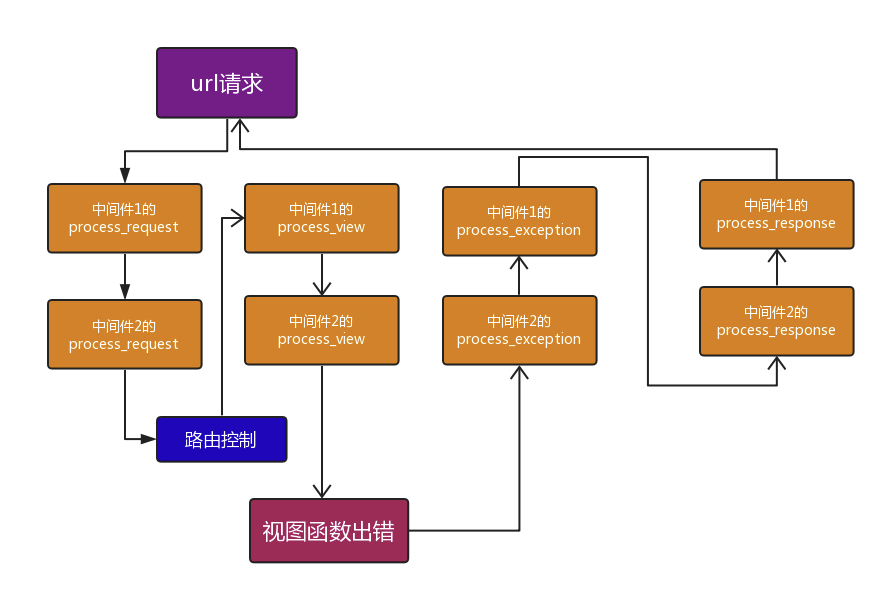中间件和auth模块
中间件
1.什么是中间件
中间件顾名思义,是介于request与response处理之间的一道处理过程,相对比较轻量级,并且在全局上改变django的输入与输出。因为改变的是全局,所以需要谨慎实用,用不好会影响到性能
2.中间件的作用
如果你想修改请求,例如被传送到view中的HttpRequest对象。 或者你想修改view返回的HttpResponse对象,这些都可以通过中间件来实现。
可能你还想在view执行之前做一些操作,这种情况就可以用 middleware来实现。
Django默认的中间件:(在django项目的settings模块中,有一个 MIDDLEWARE_CLASSES 变量,其中每一个元素就是一个中间件)
MIDDLEWARE = [
'django.middleware.security.SecurityMiddleware',
'django.contrib.sessions.middleware.SessionMiddleware',
'django.middleware.common.CommonMiddleware',
'django.middleware.csrf.CsrfViewMiddleware',
'django.contrib.auth.middleware.AuthenticationMiddleware',
'django.contrib.messages.middleware.MessageMiddleware',
'django.middleware.clickjacking.XFrameOptionsMiddleware',
]
3.自定义中间件
from django.utils.deprecation import MiddlewareMixin
class MyMiddle(MiddlewareMixin):
def process_request(self, request): # request时触发
print('middle request')
def process_response(self, request, response): # response时触发
print('process_response')
return response
def process_view(self, request, callback, callback_args, callback_kwargs): # 路由到视图函数之间触发
print('process_view')
# callback(request)
def process_exception(self, request, exception): # 报错时触发
return HttpResponse(exception)
def process_template_response(self, request, response): # return views.类()时触发
print('i am process_template_response')
print(response)
return views.Test()

4.中间件应用场景
1.做IP访问频率限制
某些IP访问服务器的频率过高,进行拦截,比如限制每分钟不能超过20次。
2.URL访问过滤
如果用户访问的是login视图(放过)
如果访问其他视图,需要检测是不是有session认证,已经有了放行,
没有返回login,这样就省得在多个视图函数上写装饰器了!
5.CSRF_TOKEN跨站请求伪造
在form表单中应用:
<form action="" method="post">
{% csrf_token %}
<p>用户名:<input type="text" name="name"></p>
<p>密码:<input type="text" name="password"></p>
<p><input type="submit"></p>
</form>
在Ajax中应用:
<!DOCTYPE html>
<html lang="en">
<head>
<meta charset="UTF-8">
<script src="/static/jquery-3.3.1.js"></script>
<title>Title</title>
</head>
<body>
<form action="" method="post">
{% csrf_token %}
<p>用户名:<input type="text" name="name"></p>
<p>密码:<input type="text" name="password" id="pwd"></p>
<p><input type="submit"></p>
</form>
<button class="btn">点我</button>
</body>
<script>
$(".btn").click(function () {
$.ajax({
url: '',
type: 'post',
data: {
'name': $('[name="name"]').val(),
'password': $("#pwd").val(),
'csrfmiddlewaretoken': $('[name="csrfmiddlewaretoken"]').val()
},
success: function (data) {
console.log(data)
}
})
})
</script>
</html>
全站禁用
注释掉中间件 'django.middleware.csrf.CsrfViewMiddleware',
局部禁用
FBV中
from django.views.decorators.csrf import csrf_exempt,csrf_protect
# 不再检测,局部禁用(前提是全站使用)
# @csrf_exempt
# 检测,局部使用(前提是全站禁用)
# @csrf_protect
def csrf_token(request):
if request.method=='POST':
print(request.POST)
return HttpResponse('ok')
return render(request,'csrf_token.html')
CBV中
from django.views import View
from django.views.decorators.csrf import csrf_exempt,csrf_protect
from django.utils.decorators import method_decorator
@method_decorator(csrf_exempt,name='dispatch')
class Foo(View):
def dispatch(self, request, *args, **kwargs):
res = super().dispatch(request, *args, **kwargs)
return res
def get(self,request):
pass
def post(self,request):
pass
Auth模块
1.Auth模块常用方法
from django.contrib import auth
authenticate(request, username=name, password=pwd) 用户认证功能,返回一个 User 对象
login(request, user) 在后端为该用户生成相关session数据
logout(request) 当前请求的session信息会全部清除
is_authenticated() 判断当前请求是否通过了认证
login_requierd() 装饰器,某个视图添加登录校验
该装饰器需要在settings中添加登录地址
LOGIN_URL = '/login/' # 这里配置成你项目登录页面的路由
create_user() 创建新用户
create_superuser() 创建新的超级用户
check_password(password) 提供的一个检查密码是否正确的方法
set_password(password) 修改密码,设置完一定要调用用户对象的save方法
2.User对象的属性
User对象属性:username, password
is_staff : 用户是否拥有网站的管理权限.
is_active : 是否允许用户登录, 设置为 False,可以在不删除用户的前提下禁止用户登录。
3.扩展默认的auth_user表
model中
from django.contrib.auth.models import AbstractUser
class UserInfo(AbstractUser): # 继承父类,并派生新需要的字段
nid = models.AutoField(primary_key=True)
phone = models.CharField(max_length=11, null=True, unique=True)
def __str__(self):
return self.username
注意,需要在setting中添加AUTH_USER_MODEL = "app名.UserInfo"


